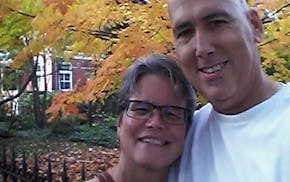In a neighborhood riddled with abandoned and dilapidated structures, it is just one house, but it's a beauty.
Gleaming hardwood floors. Dark polished woodwork. A stained-glass window and a kitchen that fits the period of its birth, 1908.
Until a couple of years ago, the house on Lyndale Avenue N. in Minneapolis had fallen apart and appeared destined to join the hundreds of homes that have fallen to neglect or been demolished following the foreclosure crisis and a tornado.
But a house rehabber/painter and a Realtor with a passion to help the North Side swooped in before the slum lords or drug dealers got to it.
With the help of their friends, mostly neighborhood residents with construction skills, they've transformed the home with their own money and sweat equity, and they did it without red tape-clogged government grants or complicated nonprofit deals. They think their experiment could be a pattern for future rehabilitation of the North Side, if only the bureaucrats would get out of the way.
"We don't have a blighted house problem. We have a bureaucracy problem," said house rehabber Brian Finstad, who bought the home with Constance Vork, a Realtor.
"This is how we should be rebuilding the North Side," Finstad wrote in a Facebook post about his project. "We don't need big initiatives with federal funding. We have the capacity within our own community members. But it is difficult for the regular folks to even acquire a boarded and vacant house because they are so entangled in bureaucracy."
When an abandoned or foreclosed house goes on the market, the listing is placed in a publication few people see, except developers who flip houses or patch them up just enough to rent out. In most cases, no one even puts a sign in the yard to let neighbors know they are for sale.
In some cases, nonprofits "scoop them up with good intentions and out-compete the private sector," said Finstad. But the houses often languish for years while the agency seeks funding or tries to comply with myriad regulations.
The city's well-intentioned attempts to ensure that rehabs are "green" often make the homes too expensive for the neighborhood.
"What is more 'green,' " said Finstad, "having a house that, although is not a rock star of efficiency, is not much different from the average house in the neighborhood? Or a hole in the ground and all of those materials in a landfill? We need to quit placing all of these expectations for how to make our communities more green upon our most distressed buildings, as the unintended consequences are actually not so green."
I met last week with Finstad, Vork, Anders Christensen and Will Lumpkins at the rehabbed house. All of them had a hand in taking the place from a dump to a neighborhood gem. But it wasn't easy. During one break-in, thieves stole copper fittings, causing water damage.
But the foursome whittled away at the house for more than a year, using wood and fixtures pulled out of the junk heap or bought on Craigslist. Finstad figures he spent about half as much as a nonprofit would have spent on the home.
"Everyone who worked on it had some connection to north Minneapolis," said Finstad, who has also assisted Nicole Curtis, star of the television show "Rehab Addict," get three North Side houses to fix up. "The capacity to do this exists in this community."
Finstad said Curtis got the homes before new regulations on green rehab went into effect and said she wouldn't have been able to do the work under the current rules.
Vork said when a house falls to a government or nonprofit, there is a tendency to look at all the deficits and decide it needs too much work, or needs to be destroyed. "They are often intimidated by old houses," she said.
Lumpkins, who lives on the North Side, learned to paint because of a program in the 1990s that paid neighborhood kids to paint houses for senior or owners too poor to do it, and he would like to see a similar program today. Now he paints for a living and runs a Facebook page (Old north Minneapolis) that supports renovations.
"Once people see some of the insides of these homes, they change their minds," said Lumpkins. "That's what we're trying to encourage. How much would it take to build something like this in the suburbs?"
What this group of rogue rehabbers would like is if the city simply offered abandoned or seized homes in north Minneapolis for a dollar, along with a request for a proposal (RFP) to weed out the riffraff. The homes would be advertised and marketed by existing agencies and neighborhood groups, even churches.
It's a good bet the original owner of the house on Lyndale wouldn't recognize it now, but he'd be proud of the outcome. A man known around the neighborhood as "Nick the Ukrainian" was a familiar sight as he walked the block with his old dog. But as Nick grew old, the house began to crumble around him.
Then Vork and Finstad persuaded a nonprofit to sell it to them, and the work began. Finstad and Lumpkins spent weeks sanding and painting as they discussed their lives and events in the neighborhood. Sometimes workers brought their kids along to hang out while they worked. When it was finished, TV's Nicole Curtis staged the home.
No "initiatives," no "developer fees."
"Historically, this is how things got done," said Finstad. "People just getting together. The myth is that north Minneapolis needs people to come from the outside and fix things, but we have the people here to do it."
The property went on the market this month. They got an offer in six days.
jtevlin@startribune.com • 612-673-1702
Follow Jon on Twitter: @jontevlin

Tevlin: 'Against all odds, I survived a career in journalism'

Tevlin: Grateful Frogtown couple fight their way back from fire and illness




